Factors Influencing Climate Change in Project Management
VerifiedAdded on 2022/12/22
|11
|1899
|74
AI Summary
This paper discusses the factors that influence climate change in project management and their impact on the environment. It explores multiple stakeholders, ambiguity of project features and resources, political/authority influence, changing project governance, significant external influences, use of new and undeveloped technology, social influences, highly regulated environment, and project duration. The paper concludes by emphasizing the importance of addressing these factors in project management practices.
Contribute Materials
Your contribution can guide someone’s learning journey. Share your
documents today.
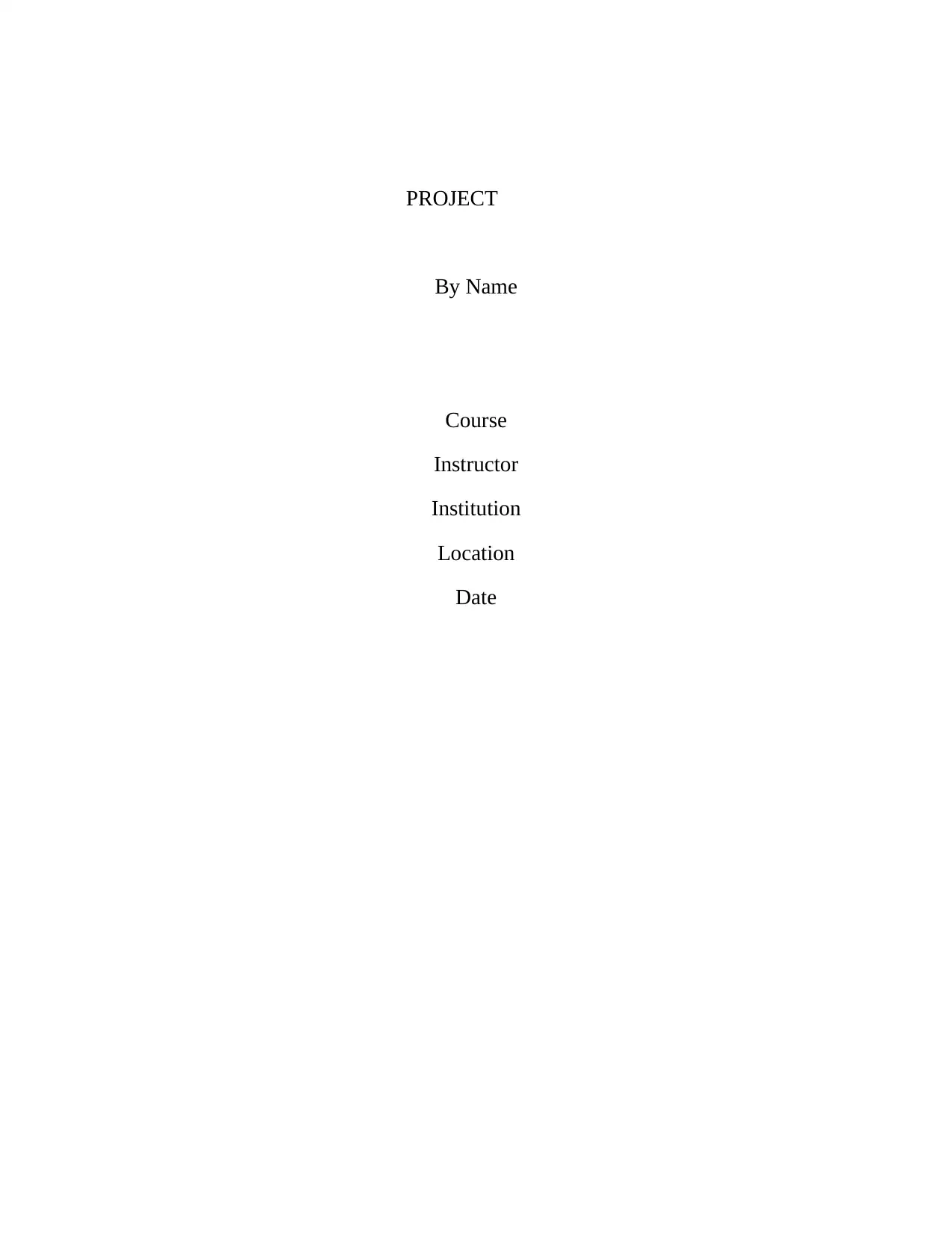
PROJECT
By Name
Course
Instructor
Institution
Location
Date
By Name
Course
Instructor
Institution
Location
Date
Secure Best Marks with AI Grader
Need help grading? Try our AI Grader for instant feedback on your assignments.
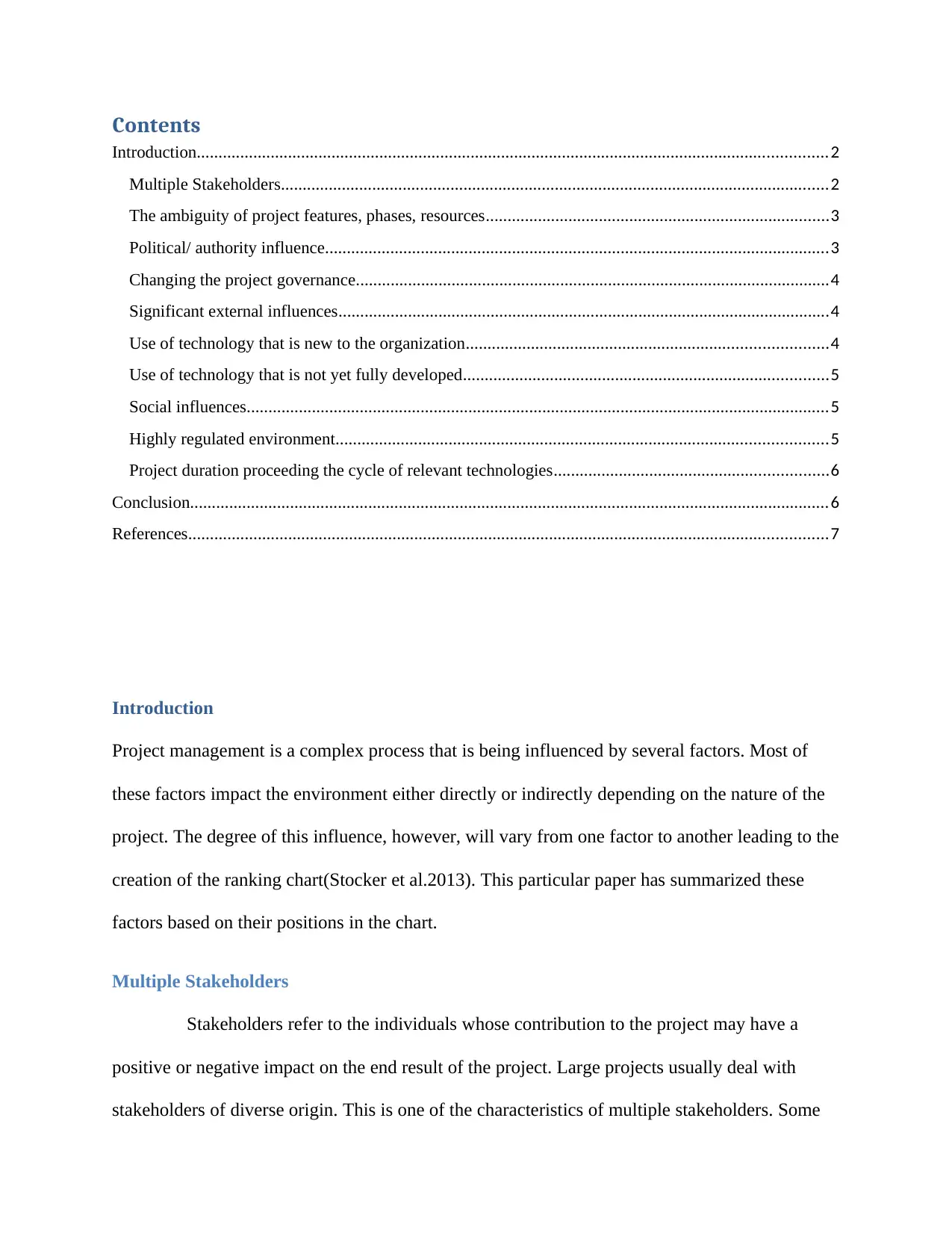
Contents
Introduction.................................................................................................................................................2
Multiple Stakeholders..............................................................................................................................2
The ambiguity of project features, phases, resources...............................................................................3
Political/ authority influence....................................................................................................................3
Changing the project governance.............................................................................................................4
Significant external influences.................................................................................................................4
Use of technology that is new to the organization...................................................................................4
Use of technology that is not yet fully developed....................................................................................5
Social influences......................................................................................................................................5
Highly regulated environment.................................................................................................................5
Project duration proceeding the cycle of relevant technologies...............................................................6
Conclusion...................................................................................................................................................6
References...................................................................................................................................................7
Introduction
Project management is a complex process that is being influenced by several factors. Most of
these factors impact the environment either directly or indirectly depending on the nature of the
project. The degree of this influence, however, will vary from one factor to another leading to the
creation of the ranking chart(Stocker et al.2013). This particular paper has summarized these
factors based on their positions in the chart.
Multiple Stakeholders
Stakeholders refer to the individuals whose contribution to the project may have a
positive or negative impact on the end result of the project. Large projects usually deal with
stakeholders of diverse origin. This is one of the characteristics of multiple stakeholders. Some
Introduction.................................................................................................................................................2
Multiple Stakeholders..............................................................................................................................2
The ambiguity of project features, phases, resources...............................................................................3
Political/ authority influence....................................................................................................................3
Changing the project governance.............................................................................................................4
Significant external influences.................................................................................................................4
Use of technology that is new to the organization...................................................................................4
Use of technology that is not yet fully developed....................................................................................5
Social influences......................................................................................................................................5
Highly regulated environment.................................................................................................................5
Project duration proceeding the cycle of relevant technologies...............................................................6
Conclusion...................................................................................................................................................6
References...................................................................................................................................................7
Introduction
Project management is a complex process that is being influenced by several factors. Most of
these factors impact the environment either directly or indirectly depending on the nature of the
project. The degree of this influence, however, will vary from one factor to another leading to the
creation of the ranking chart(Stocker et al.2013). This particular paper has summarized these
factors based on their positions in the chart.
Multiple Stakeholders
Stakeholders refer to the individuals whose contribution to the project may have a
positive or negative impact on the end result of the project. Large projects usually deal with
stakeholders of diverse origin. This is one of the characteristics of multiple stakeholders. Some
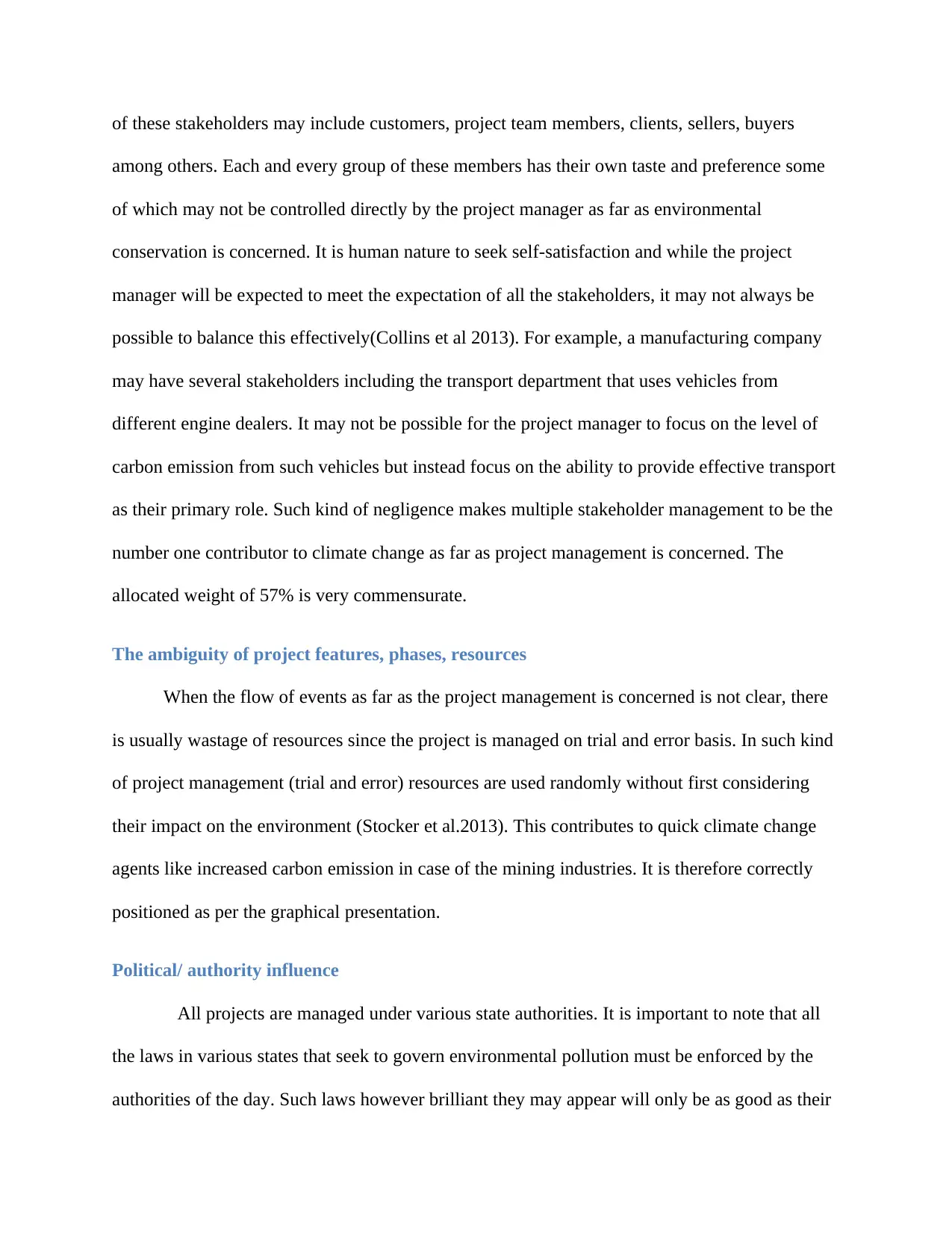
of these stakeholders may include customers, project team members, clients, sellers, buyers
among others. Each and every group of these members has their own taste and preference some
of which may not be controlled directly by the project manager as far as environmental
conservation is concerned. It is human nature to seek self-satisfaction and while the project
manager will be expected to meet the expectation of all the stakeholders, it may not always be
possible to balance this effectively(Collins et al 2013). For example, a manufacturing company
may have several stakeholders including the transport department that uses vehicles from
different engine dealers. It may not be possible for the project manager to focus on the level of
carbon emission from such vehicles but instead focus on the ability to provide effective transport
as their primary role. Such kind of negligence makes multiple stakeholder management to be the
number one contributor to climate change as far as project management is concerned. The
allocated weight of 57% is very commensurate.
The ambiguity of project features, phases, resources
When the flow of events as far as the project management is concerned is not clear, there
is usually wastage of resources since the project is managed on trial and error basis. In such kind
of project management (trial and error) resources are used randomly without first considering
their impact on the environment (Stocker et al.2013). This contributes to quick climate change
agents like increased carbon emission in case of the mining industries. It is therefore correctly
positioned as per the graphical presentation.
Political/ authority influence
All projects are managed under various state authorities. It is important to note that all
the laws in various states that seek to govern environmental pollution must be enforced by the
authorities of the day. Such laws however brilliant they may appear will only be as good as their
among others. Each and every group of these members has their own taste and preference some
of which may not be controlled directly by the project manager as far as environmental
conservation is concerned. It is human nature to seek self-satisfaction and while the project
manager will be expected to meet the expectation of all the stakeholders, it may not always be
possible to balance this effectively(Collins et al 2013). For example, a manufacturing company
may have several stakeholders including the transport department that uses vehicles from
different engine dealers. It may not be possible for the project manager to focus on the level of
carbon emission from such vehicles but instead focus on the ability to provide effective transport
as their primary role. Such kind of negligence makes multiple stakeholder management to be the
number one contributor to climate change as far as project management is concerned. The
allocated weight of 57% is very commensurate.
The ambiguity of project features, phases, resources
When the flow of events as far as the project management is concerned is not clear, there
is usually wastage of resources since the project is managed on trial and error basis. In such kind
of project management (trial and error) resources are used randomly without first considering
their impact on the environment (Stocker et al.2013). This contributes to quick climate change
agents like increased carbon emission in case of the mining industries. It is therefore correctly
positioned as per the graphical presentation.
Political/ authority influence
All projects are managed under various state authorities. It is important to note that all
the laws in various states that seek to govern environmental pollution must be enforced by the
authorities of the day. Such laws however brilliant they may appear will only be as good as their
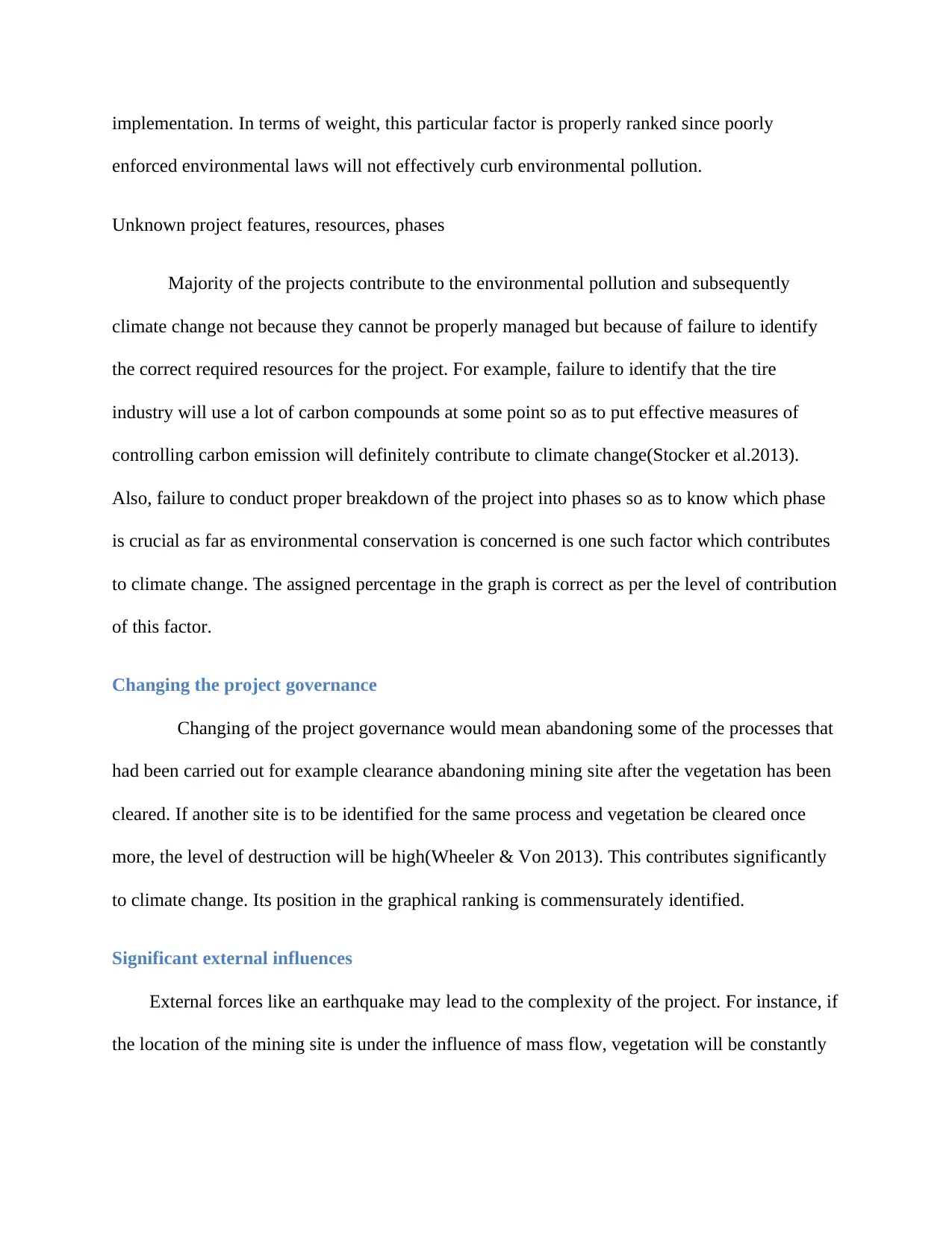
implementation. In terms of weight, this particular factor is properly ranked since poorly
enforced environmental laws will not effectively curb environmental pollution.
Unknown project features, resources, phases
Majority of the projects contribute to the environmental pollution and subsequently
climate change not because they cannot be properly managed but because of failure to identify
the correct required resources for the project. For example, failure to identify that the tire
industry will use a lot of carbon compounds at some point so as to put effective measures of
controlling carbon emission will definitely contribute to climate change(Stocker et al.2013).
Also, failure to conduct proper breakdown of the project into phases so as to know which phase
is crucial as far as environmental conservation is concerned is one such factor which contributes
to climate change. The assigned percentage in the graph is correct as per the level of contribution
of this factor.
Changing the project governance
Changing of the project governance would mean abandoning some of the processes that
had been carried out for example clearance abandoning mining site after the vegetation has been
cleared. If another site is to be identified for the same process and vegetation be cleared once
more, the level of destruction will be high(Wheeler & Von 2013). This contributes significantly
to climate change. Its position in the graphical ranking is commensurately identified.
Significant external influences
External forces like an earthquake may lead to the complexity of the project. For instance, if
the location of the mining site is under the influence of mass flow, vegetation will be constantly
enforced environmental laws will not effectively curb environmental pollution.
Unknown project features, resources, phases
Majority of the projects contribute to the environmental pollution and subsequently
climate change not because they cannot be properly managed but because of failure to identify
the correct required resources for the project. For example, failure to identify that the tire
industry will use a lot of carbon compounds at some point so as to put effective measures of
controlling carbon emission will definitely contribute to climate change(Stocker et al.2013).
Also, failure to conduct proper breakdown of the project into phases so as to know which phase
is crucial as far as environmental conservation is concerned is one such factor which contributes
to climate change. The assigned percentage in the graph is correct as per the level of contribution
of this factor.
Changing the project governance
Changing of the project governance would mean abandoning some of the processes that
had been carried out for example clearance abandoning mining site after the vegetation has been
cleared. If another site is to be identified for the same process and vegetation be cleared once
more, the level of destruction will be high(Wheeler & Von 2013). This contributes significantly
to climate change. Its position in the graphical ranking is commensurately identified.
Significant external influences
External forces like an earthquake may lead to the complexity of the project. For instance, if
the location of the mining site is under the influence of mass flow, vegetation will be constantly
Secure Best Marks with AI Grader
Need help grading? Try our AI Grader for instant feedback on your assignments.
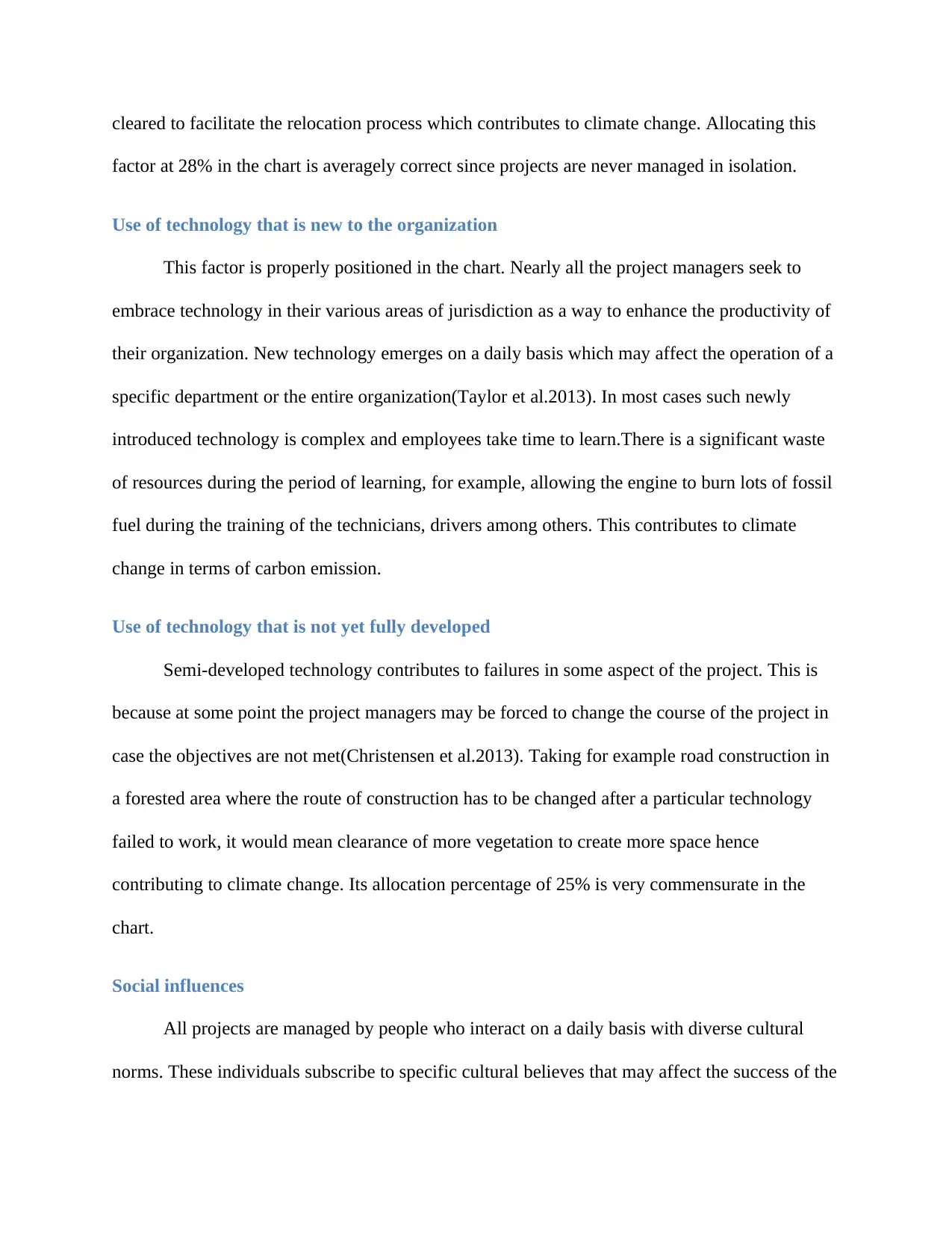
cleared to facilitate the relocation process which contributes to climate change. Allocating this
factor at 28% in the chart is averagely correct since projects are never managed in isolation.
Use of technology that is new to the organization
This factor is properly positioned in the chart. Nearly all the project managers seek to
embrace technology in their various areas of jurisdiction as a way to enhance the productivity of
their organization. New technology emerges on a daily basis which may affect the operation of a
specific department or the entire organization(Taylor et al.2013). In most cases such newly
introduced technology is complex and employees take time to learn.There is a significant waste
of resources during the period of learning, for example, allowing the engine to burn lots of fossil
fuel during the training of the technicians, drivers among others. This contributes to climate
change in terms of carbon emission.
Use of technology that is not yet fully developed
Semi-developed technology contributes to failures in some aspect of the project. This is
because at some point the project managers may be forced to change the course of the project in
case the objectives are not met(Christensen et al.2013). Taking for example road construction in
a forested area where the route of construction has to be changed after a particular technology
failed to work, it would mean clearance of more vegetation to create more space hence
contributing to climate change. Its allocation percentage of 25% is very commensurate in the
chart.
Social influences
All projects are managed by people who interact on a daily basis with diverse cultural
norms. These individuals subscribe to specific cultural believes that may affect the success of the
factor at 28% in the chart is averagely correct since projects are never managed in isolation.
Use of technology that is new to the organization
This factor is properly positioned in the chart. Nearly all the project managers seek to
embrace technology in their various areas of jurisdiction as a way to enhance the productivity of
their organization. New technology emerges on a daily basis which may affect the operation of a
specific department or the entire organization(Taylor et al.2013). In most cases such newly
introduced technology is complex and employees take time to learn.There is a significant waste
of resources during the period of learning, for example, allowing the engine to burn lots of fossil
fuel during the training of the technicians, drivers among others. This contributes to climate
change in terms of carbon emission.
Use of technology that is not yet fully developed
Semi-developed technology contributes to failures in some aspect of the project. This is
because at some point the project managers may be forced to change the course of the project in
case the objectives are not met(Christensen et al.2013). Taking for example road construction in
a forested area where the route of construction has to be changed after a particular technology
failed to work, it would mean clearance of more vegetation to create more space hence
contributing to climate change. Its allocation percentage of 25% is very commensurate in the
chart.
Social influences
All projects are managed by people who interact on a daily basis with diverse cultural
norms. These individuals subscribe to specific cultural believes that may affect the success of the
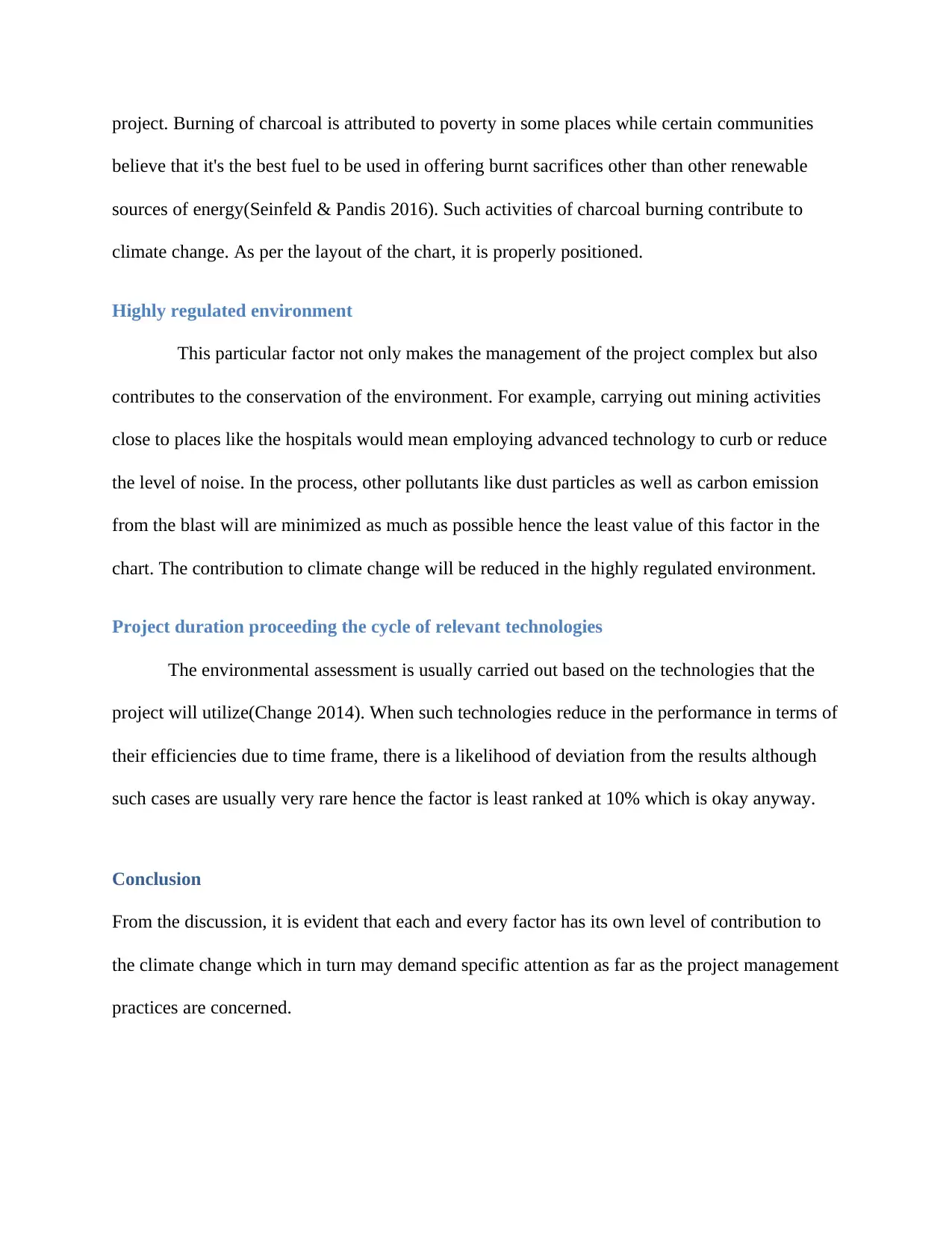
project. Burning of charcoal is attributed to poverty in some places while certain communities
believe that it's the best fuel to be used in offering burnt sacrifices other than other renewable
sources of energy(Seinfeld & Pandis 2016). Such activities of charcoal burning contribute to
climate change. As per the layout of the chart, it is properly positioned.
Highly regulated environment
This particular factor not only makes the management of the project complex but also
contributes to the conservation of the environment. For example, carrying out mining activities
close to places like the hospitals would mean employing advanced technology to curb or reduce
the level of noise. In the process, other pollutants like dust particles as well as carbon emission
from the blast will are minimized as much as possible hence the least value of this factor in the
chart. The contribution to climate change will be reduced in the highly regulated environment.
Project duration proceeding the cycle of relevant technologies
The environmental assessment is usually carried out based on the technologies that the
project will utilize(Change 2014). When such technologies reduce in the performance in terms of
their efficiencies due to time frame, there is a likelihood of deviation from the results although
such cases are usually very rare hence the factor is least ranked at 10% which is okay anyway.
Conclusion
From the discussion, it is evident that each and every factor has its own level of contribution to
the climate change which in turn may demand specific attention as far as the project management
practices are concerned.
believe that it's the best fuel to be used in offering burnt sacrifices other than other renewable
sources of energy(Seinfeld & Pandis 2016). Such activities of charcoal burning contribute to
climate change. As per the layout of the chart, it is properly positioned.
Highly regulated environment
This particular factor not only makes the management of the project complex but also
contributes to the conservation of the environment. For example, carrying out mining activities
close to places like the hospitals would mean employing advanced technology to curb or reduce
the level of noise. In the process, other pollutants like dust particles as well as carbon emission
from the blast will are minimized as much as possible hence the least value of this factor in the
chart. The contribution to climate change will be reduced in the highly regulated environment.
Project duration proceeding the cycle of relevant technologies
The environmental assessment is usually carried out based on the technologies that the
project will utilize(Change 2014). When such technologies reduce in the performance in terms of
their efficiencies due to time frame, there is a likelihood of deviation from the results although
such cases are usually very rare hence the factor is least ranked at 10% which is okay anyway.
Conclusion
From the discussion, it is evident that each and every factor has its own level of contribution to
the climate change which in turn may demand specific attention as far as the project management
practices are concerned.
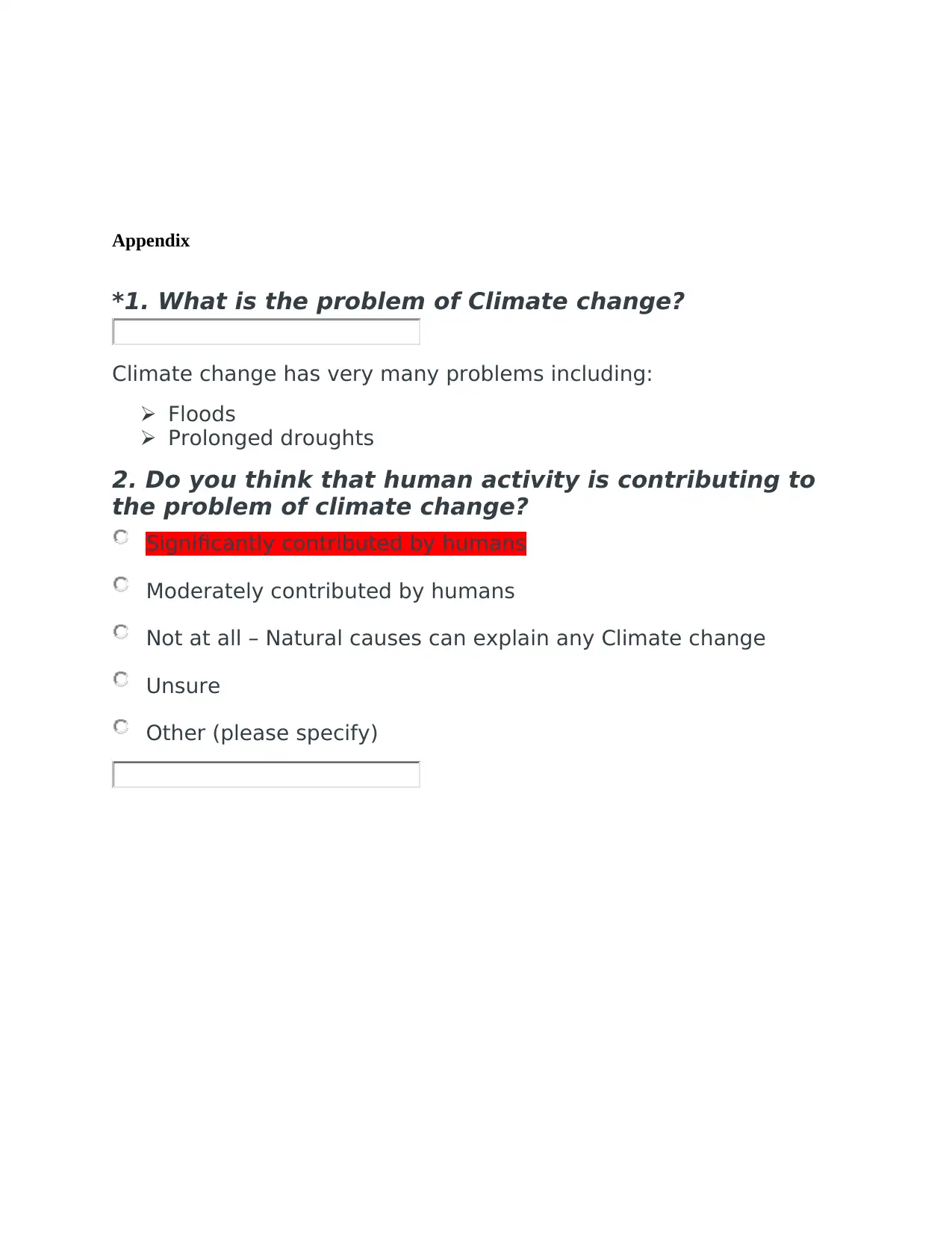
Appendix
*1. What is the problem of Climate change?
Climate change has very many problems including:
Floods
Prolonged droughts
2. Do you think that human activity is contributing to
the problem of climate change?
Significantly contributed by humans
Moderately contributed by humans
Not at all – Natural causes can explain any Climate change
Unsure
Other (please specify)
*1. What is the problem of Climate change?
Climate change has very many problems including:
Floods
Prolonged droughts
2. Do you think that human activity is contributing to
the problem of climate change?
Significantly contributed by humans
Moderately contributed by humans
Not at all – Natural causes can explain any Climate change
Unsure
Other (please specify)
Paraphrase This Document
Need a fresh take? Get an instant paraphrase of this document with our AI Paraphraser
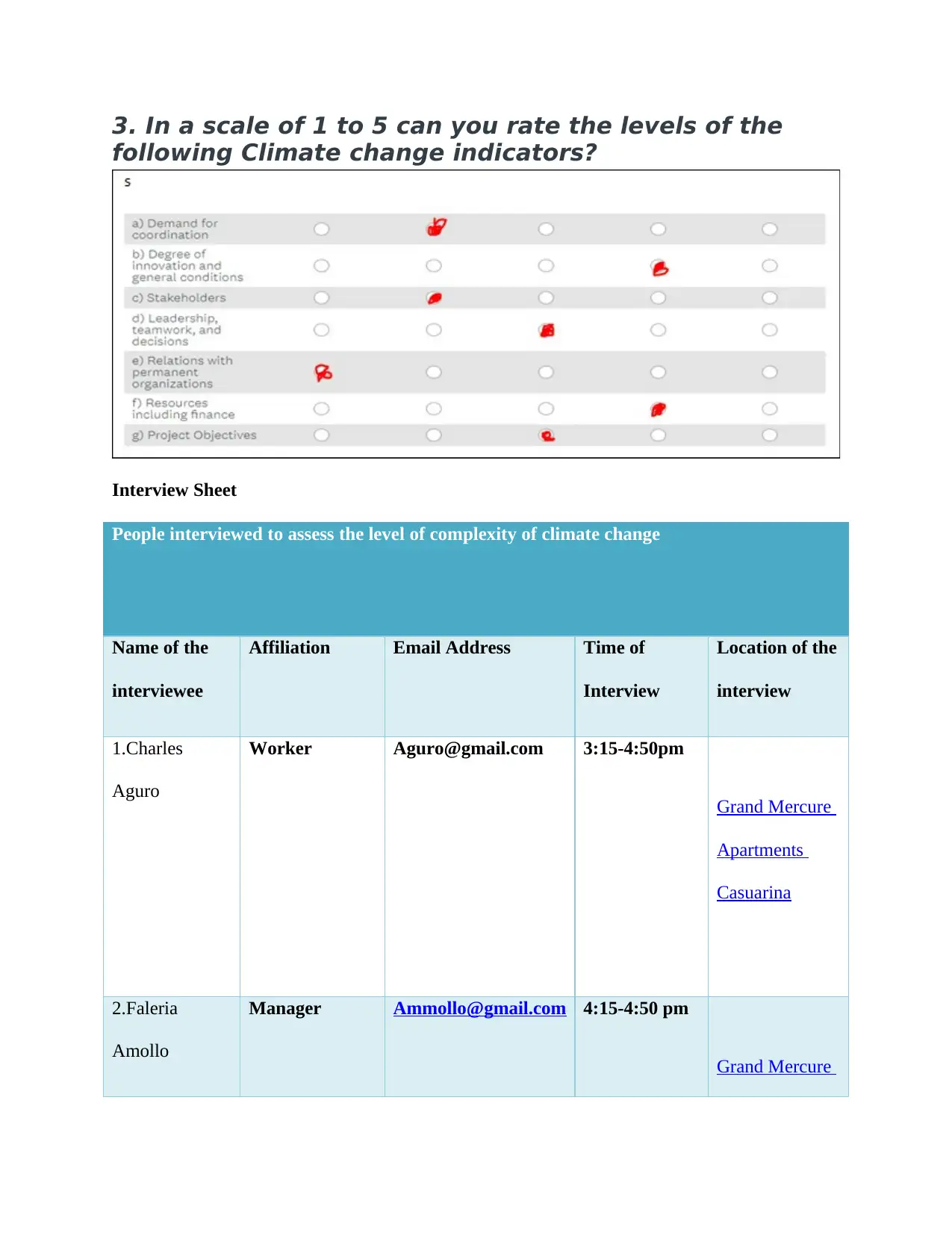
3. In a scale of 1 to 5 can you rate the levels of the
following Climate change indicators?
Interview Sheet
People interviewed to assess the level of complexity of climate change
Name of the
interviewee
Affiliation Email Address Time of
Interview
Location of the
interview
1.Charles
Aguro
Worker Aguro@gmail.com 3:15-4:50pm
Grand Mercure
Apartments
Casuarina
2.Faleria
Amollo
Manager Ammollo@gmail.com 4:15-4:50 pm
Grand Mercure
following Climate change indicators?
Interview Sheet
People interviewed to assess the level of complexity of climate change
Name of the
interviewee
Affiliation Email Address Time of
Interview
Location of the
interview
1.Charles
Aguro
Worker Aguro@gmail.com 3:15-4:50pm
Grand Mercure
Apartments
Casuarina
2.Faleria
Amollo
Manager Ammollo@gmail.com 4:15-4:50 pm
Grand Mercure

Apartments
Casuarina
3.Mboga Obiria Tutor Tutor@gmail.com 5:15-6:00pm
Amoudara
4.Perepetu Peretus@gamail.com 10:20-11:00
Rouydadnews
5.Chieth
Gweno
Environmentist Chieth@gmail.com 11:15-12:20
Grand Mercure
Apartments
Casuarina
6.Pier Meru Environmentist Pier@gmail.com 15:00-16:25
Grand Mercure
Apartments
Casuarina
Casuarina
3.Mboga Obiria Tutor Tutor@gmail.com 5:15-6:00pm
Amoudara
4.Perepetu Peretus@gamail.com 10:20-11:00
Rouydadnews
5.Chieth
Gweno
Environmentist Chieth@gmail.com 11:15-12:20
Grand Mercure
Apartments
Casuarina
6.Pier Meru Environmentist Pier@gmail.com 15:00-16:25
Grand Mercure
Apartments
Casuarina
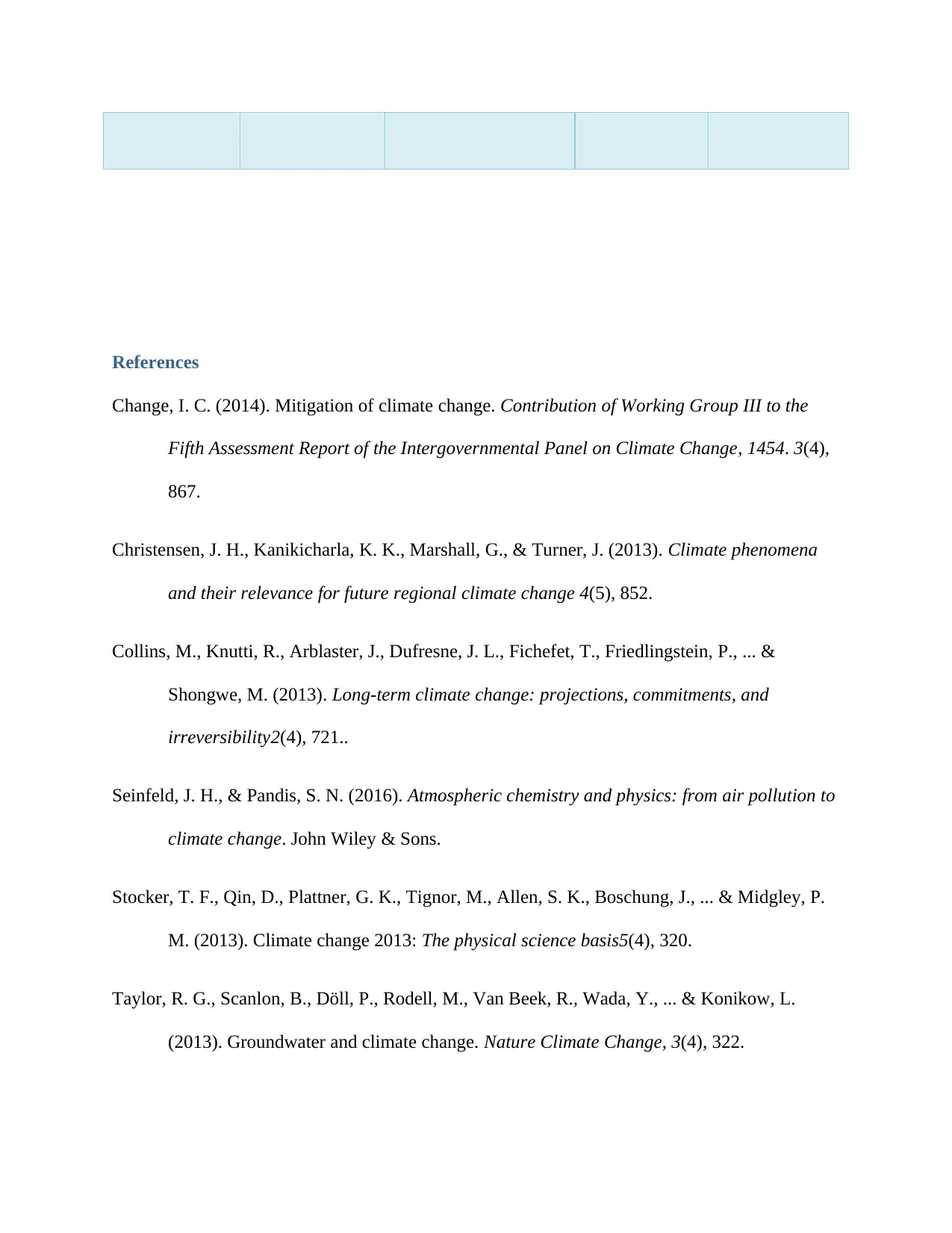
References
Change, I. C. (2014). Mitigation of climate change. Contribution of Working Group III to the
Fifth Assessment Report of the Intergovernmental Panel on Climate Change, 1454. 3(4),
867.
Christensen, J. H., Kanikicharla, K. K., Marshall, G., & Turner, J. (2013). Climate phenomena
and their relevance for future regional climate change 4(5), 852.
Collins, M., Knutti, R., Arblaster, J., Dufresne, J. L., Fichefet, T., Friedlingstein, P., ... &
Shongwe, M. (2013). Long-term climate change: projections, commitments, and
irreversibility2(4), 721..
Seinfeld, J. H., & Pandis, S. N. (2016). Atmospheric chemistry and physics: from air pollution to
climate change. John Wiley & Sons.
Stocker, T. F., Qin, D., Plattner, G. K., Tignor, M., Allen, S. K., Boschung, J., ... & Midgley, P.
M. (2013). Climate change 2013: The physical science basis5(4), 320.
Taylor, R. G., Scanlon, B., Döll, P., Rodell, M., Van Beek, R., Wada, Y., ... & Konikow, L.
(2013). Groundwater and climate change. Nature Climate Change, 3(4), 322.
Change, I. C. (2014). Mitigation of climate change. Contribution of Working Group III to the
Fifth Assessment Report of the Intergovernmental Panel on Climate Change, 1454. 3(4),
867.
Christensen, J. H., Kanikicharla, K. K., Marshall, G., & Turner, J. (2013). Climate phenomena
and their relevance for future regional climate change 4(5), 852.
Collins, M., Knutti, R., Arblaster, J., Dufresne, J. L., Fichefet, T., Friedlingstein, P., ... &
Shongwe, M. (2013). Long-term climate change: projections, commitments, and
irreversibility2(4), 721..
Seinfeld, J. H., & Pandis, S. N. (2016). Atmospheric chemistry and physics: from air pollution to
climate change. John Wiley & Sons.
Stocker, T. F., Qin, D., Plattner, G. K., Tignor, M., Allen, S. K., Boschung, J., ... & Midgley, P.
M. (2013). Climate change 2013: The physical science basis5(4), 320.
Taylor, R. G., Scanlon, B., Döll, P., Rodell, M., Van Beek, R., Wada, Y., ... & Konikow, L.
(2013). Groundwater and climate change. Nature Climate Change, 3(4), 322.
Secure Best Marks with AI Grader
Need help grading? Try our AI Grader for instant feedback on your assignments.

Wheeler, T., & Von Braun, J. (2013). Climate change impacts on global food
security. Science, 341(6145), 508-513.
security. Science, 341(6145), 508-513.
1 out of 11
Your All-in-One AI-Powered Toolkit for Academic Success.
+13062052269
info@desklib.com
Available 24*7 on WhatsApp / Email
![[object Object]](/_next/static/media/star-bottom.7253800d.svg)
Unlock your academic potential
© 2024 | Zucol Services PVT LTD | All rights reserved.
![ENGLISH ASSIGNMENTS [Author Name(s)] [Institutional Affiliation(s)]](/_next/image/?url=https%3A%2F%2Fdesklib.com%2Fmedia%2Fimages%2Fyr%2F221317a0bc164411bc4522b36893abae.jpg&w=256&q=75)